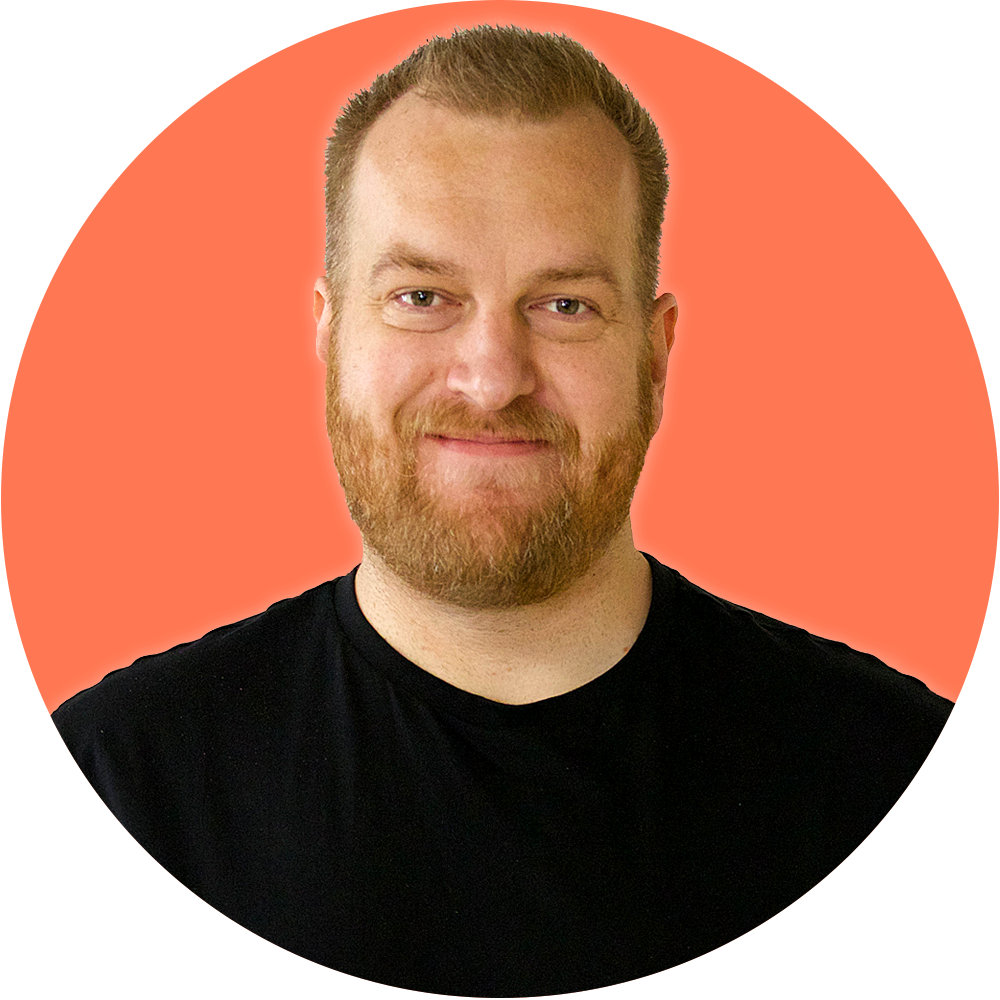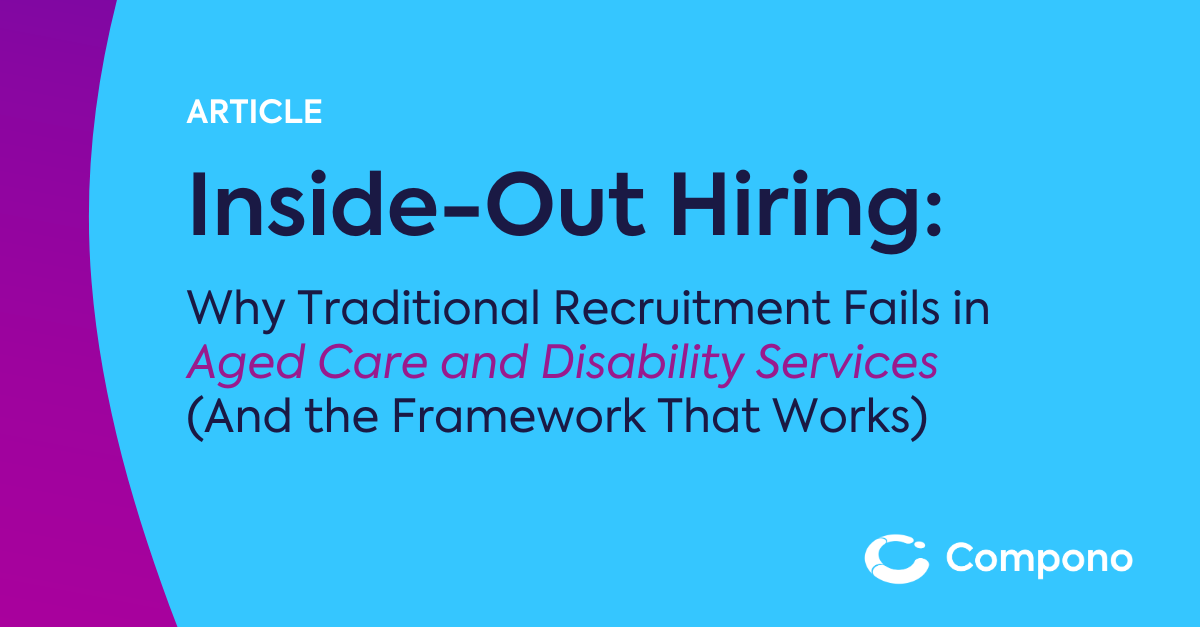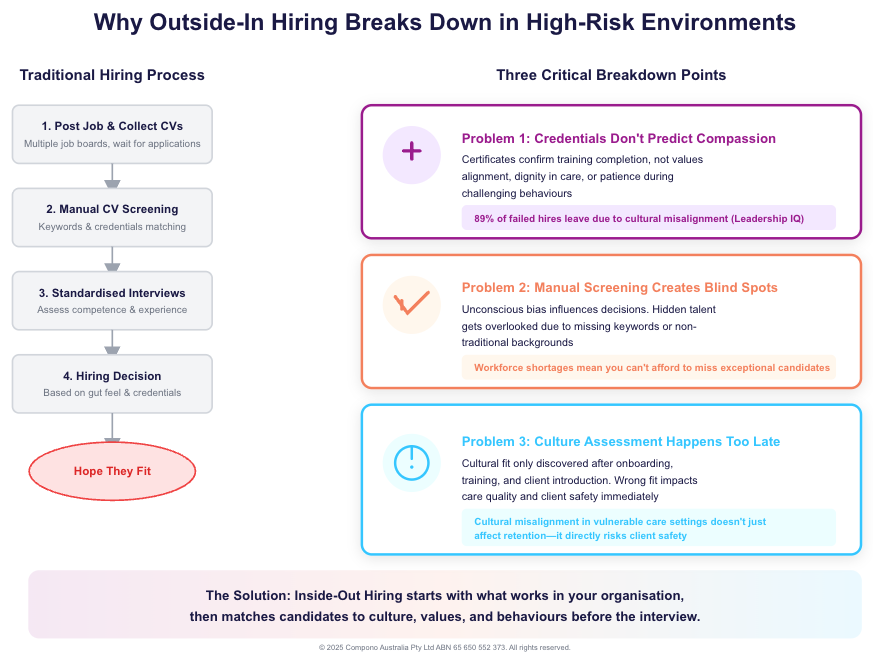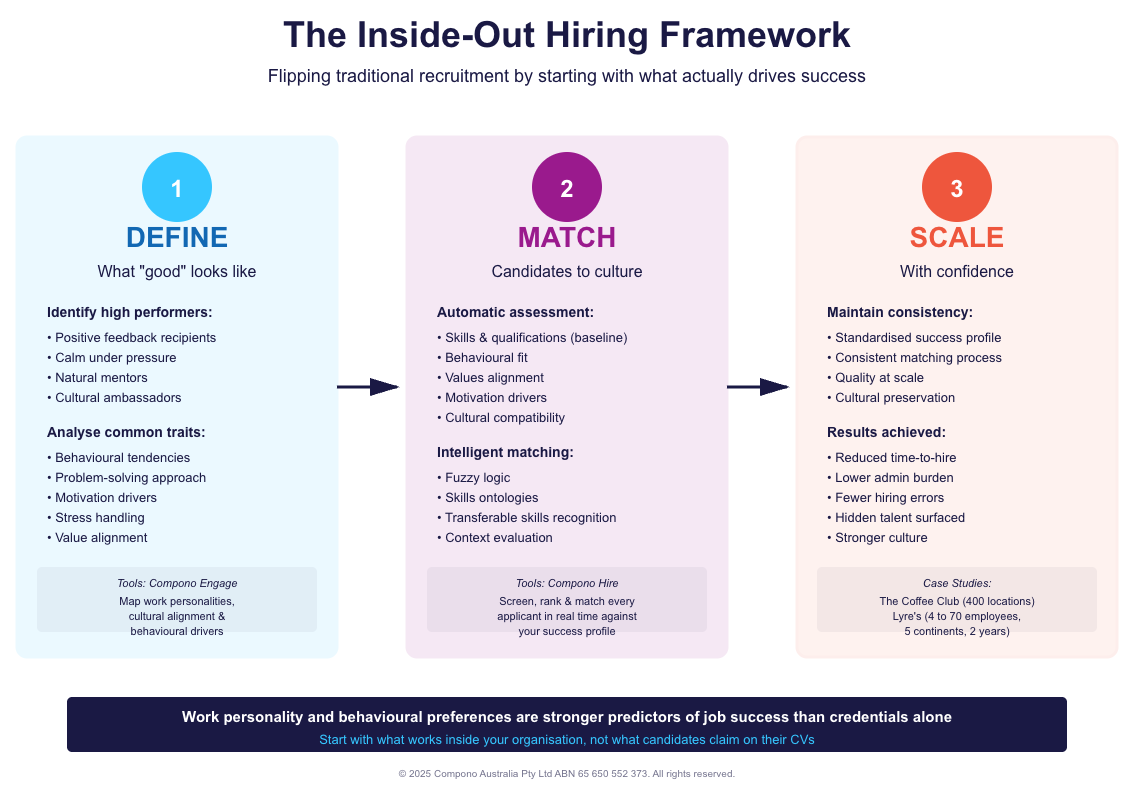The Balance Between Culture Fit and Diversity in Hiring
Hiring for ‘culture fit’ and fostering workplace diversity have often been seen as opposing forces in recruitment. But is that necessarily true? The...
Become the expert on delivering
valid and fair assessments for
your training and education.
Hire
|
Engage
|
Develop
|
|
Automatically match to candidates who are a great fit for your team culture and who are intrinsically motivated to succeed. |
Deeply understand your organisation with science-backed analytics on your culture, team design, and engagement. |
Back your onboarding, compliance and skill development with industry-leading credentialling, competency and capability expertise.
|
Hey Compono helps you understand your personality and how to turn it into your superpower.
First 1,000 users get 10 minutes free.
Just $15 a month after that — cancel anytime.
9 min read
 Mathan Allington
Oct 28, 2025 4:35:01 PM
Mathan Allington
Oct 28, 2025 4:35:01 PM

Every hire in aged care and disability services carries weight most businesses never face. When someone joins your team, they don't just fill a shift. They hold someone's health, safety, and in many cases, their life in their hands.
For most organisations, a bad hire means lost productivity or increased costs. In aged care, disability services, healthcare, and childcare, the wrong hire can lead to harm, damaged trust, regulatory consequences, and in extreme cases, loss of funding. The stakes could not be higher.
Yet most recruitment processes in these sectors still follow the same broken "Outside-In" model that dominates corporate hiring. Post a job. Collect applications. Review CVs manually. Hope the new hire works out once they start.
Research shows why this approach fails consistently. Harvard Business Review reports that 80% of employee turnover stems from bad hiring decisions. Leadership IQ found that 89% of failed hires leave due to cultural or attitudinal misalignment, not lack of skills. Most damning, only 61% of HR leaders would rehire their most recent hires, according to SHRM.
When you work with vulnerable populations, you cannot afford these failure rates. Traditional recruitment optimises for speed and credential matching whilst ignoring the factors that actually predict safe, compassionate care: values alignment, behavioural fit, and cultural compatibility.
This is why forward-thinking organisations in high-risk sectors are adopting the Inside-Out hiring framework. Rather than starting with what candidates claim on a CV, this approach begins with what already works inside your organisation.
Traditional hiring follows a predictable sequence. You identify a vacancy, write a job description, post to multiple job boards, wait for applications to flood in, then manually sift through CVs looking for relevant keywords and qualifications. Eventually, you shortlist candidates based primarily on their credentials and experience, conduct interviews asking standardised questions, and make hiring decisions based largely on gut feel about who seemed most competent.
This process faces three fundamental problems when applied to aged care, disability services, healthcare, and childcare roles.
A certificate in aged care or disability support confirms someone completed training. It tells you nothing about whether they treat clients with dignity, maintain patience during challenging behaviours, or align with your organisation's care philosophy. Skills can be taught. Values and behavioural tendencies are remarkably stable across someone's career.
When a Queensland-based aged care provider faced this challenge whilst processing more than 15,000 applications annually, they recognised that cultural fit often meant the difference between safe care and unsafe care. Yet their spreadsheet-driven recruitment process provided no systematic way to assess these critical factors.
When HR teams manually review hundreds of CVs, two problems emerge simultaneously. First, unconscious bias inevitably influences decisions. Research consistently demonstrates that identical CVs receive different responses based solely on the applicant's perceived gender, age, or cultural background. Second, exceptional candidates with non-traditional backgrounds get overlooked because their CVs don't contain the exact keywords recruiters are scanning for.
In sectors facing chronic workforce shortages, you cannot afford to miss hidden talent in your applicant pool. Yet rigid keyword matching and manual screening processes systematically exclude people who would excel in your environment.
Most organisations only discover whether someone fits their culture after they start. By then, you have invested weeks in recruitment, completed onboarding, assigned shifts, and introduced the new hire to vulnerable clients. If the fit is wrong, the consequences ripple through your entire operation.
Aged care, disability services, and healthcare organisations operate with unique cultures shaped by their care models, client populations, regulatory environments, and community connections. Someone who thrived in a large metropolitan hospital may struggle in a small community aged care facility. A support worker perfect for a high-support disability service may feel overwhelmed in a more independent living environment.
Cultural misalignment does not just affect retention. In sectors serving vulnerable populations, it directly impacts care quality and client safety.

The Inside-Out hiring model flips traditional recruitment on its head. Instead of starting with what candidates claim, you begin by understanding what actually drives success inside your organisation.
This framework consists of three stages: Define, Match, and Scale.
Most organisations have implicit knowledge about what makes someone successful in their environment. They know which team members consistently deliver outstanding care, which behavioural traits predict long-term retention, and which values alignment leads to safe, compassionate service delivery.
The challenge is making this implicit knowledge explicit and measurable.
Start by identifying your high performers. Who consistently receives positive feedback from clients and families? Which team members remain calm and compassionate during challenging situations? Who naturally mentors newer staff and reinforces your cultural values?
Next, analyse what these exceptional employees have in common. This extends far beyond their qualifications. Look at their behavioural tendencies. How do they approach problem-solving? What motivates them? How do they handle stress? What values guide their decision-making?
Organisational psychology research demonstrates that work personality, behavioural preferences, and value systems are far stronger predictors of job success than credentials alone. By mapping the characteristics of your best people, you create a benchmark for what success looks like in your specific environment.
This is not about finding identical copies of your star employees. Research from the University of British Columbia shows that diversity in thinking styles and problem-solving approaches actually strengthens team performance. The goal is identifying the core values and behavioural characteristics that predict both cultural fit and care quality in your organisation.
Platforms like Compono Engage help organisations systematically identify these patterns by mapping work personalities, cultural alignment, and behavioural drivers across existing teams. This creates an evidence-based definition of what success looks like inside your organisation, rather than relying on assumptions or generic job descriptions.
Once you understand what drives success internally, you can evaluate candidates against these benchmarks from the very beginning of the recruitment process.
This is where Inside-Out hiring diverges dramatically from traditional approaches. Rather than manually reviewing CVs and hoping to identify the right people, you use behavioural science to automatically screen, rank, and match every applicant.
Modern recruitment technology can assess candidates across multiple dimensions simultaneously. Skills and qualifications provide the baseline. You still need people with appropriate certifications, especially in regulated sectors like aged care and healthcare. But on top of credentials, intelligent matching systems evaluate behavioural fit, values alignment, motivation drivers, and cultural compatibility.
This happens automatically for every single applicant. No one gets overlooked because their CV did not contain the right keyword. Hidden gems in your talent pool rise to the top based on genuine fit, whilst candidates who look perfect on paper but are fundamentally misaligned with your culture get filtered out early.
The methodology relies on fuzzy logic and proprietary skills ontologies rather than simple one-to-one keyword matching. The system understands relationships between different types of qualifications, recognises transferable skills, and evaluates experience in context.
For example, someone with five years in disability support may have highly relevant experience for an aged care role, even if their CV never mentions "aged care." Traditional keyword searches miss this connection. Intelligent matching surfaces it automatically.
Compono Hire applies this approach by combining traditional ATS functionality with behavioural science-powered matching. Every applicant gets screened, ranked, and matched in real time against your organisation's specific success profile. The result is shortlists you can trust, with candidates who are not only qualified but genuinely aligned with your culture and care model.
The final stage addresses a challenge every growing organisation in these sectors faces: how do you maintain quality and cultural consistency whilst rapidly expanding your workforce?
When The Coffee Club needed to implement consistent hiring across 400 locations nationwide, they could not afford to have cultural fit vary from site to site. The solution was standardising the success profile and matching process whilst allowing local hiring managers to make final decisions with confidence.
Similarly, when Lyre's scaled from 4 to 70 employees across 5 continents in just 2 years, they maintained their culture and quality by clearly defining what success looked like, then rigorously matching every candidate against those criteria throughout their hypergrowth phase.
For aged care and disability service providers expanding into new regions, opening additional facilities, or scaling services to meet growing demand, this becomes essential. You need recruitment processes that are simultaneously scalable and selective.
Inside-Out hiring achieves this by automating the screening and matching stages whilst preserving human judgment where it matters most. Technology handles the heavy lifting of processing applications, identifying qualified candidates, and assessing cultural fit. HR professionals and hiring managers focus their time on interviewing the right shortlisted candidates and making final hiring decisions.
This dramatically reduces time-to-hire without sacrificing quality. Admin burden drops. Errors decrease. Hidden talent gets surfaced. Most importantly, every new hire strengthens rather than dilutes your organisational culture.

The Australian regulatory environment for aged care and disability services adds additional complexity to recruitment. Organisations must navigate NDIS worker screening requirements, Aged Care Quality Standards compliance, working with children checks where relevant, and state-based registration requirements.
Inside-Out hiring does not replace compliance checks. It complements them by ensuring that once candidates pass regulatory requirements, you are selecting people genuinely suited to your environment.
The Australian aged care and disability sectors also face specific workforce challenges. With an ageing population and expanding NDIS services, demand for qualified workers significantly outstrips supply. Organisations competing for the same talent pool cannot afford lengthy recruitment processes or high turnover rates.
Research from the Aged Care Workforce Strategy Taskforce shows that improving job matching and cultural fit can reduce turnover by 15-25% in aged care settings. Given that replacing an aged care worker costs approximately $15,000 when factoring in recruitment, training, and productivity loss, the ROI of better hiring processes is substantial.
Additionally, Australia's geographic diversity creates challenges for organisations operating across multiple regions. What works in metropolitan Sydney may not work in regional Queensland. Inside-Out hiring allows you to maintain consistent cultural standards whilst adapting to local workforce characteristics and community expectations.
Adopting Inside-Out hiring requires thoughtful implementation. Here's how to approach the transition effectively.
Start with your best people. Before changing anything about your recruitment process, invest time genuinely understanding what makes your high performers successful. Interview them. Observe them. Map their behavioural tendencies and values. This creates the foundation for everything that follows.
Involve your frontline teams. The people delivering care daily understand what behaviours and attitudes lead to quality outcomes. Include them in defining success criteria. Their insights are invaluable and their buy-in is essential.
Integrate with existing systems. Inside-Out hiring should work alongside your current HRIS and workforce management tools. Look for platforms that integrate seamlessly rather than creating additional silos.
Measure what matters. Track metrics beyond time-to-hire. Monitor quality of hire through 90-day retention rates, manager satisfaction scores, client feedback, and cultural fit assessments. These indicators reveal whether your new approach actually improves hiring outcomes.
Iterate based on results. Your definition of success will evolve as your organisation grows and your services change. Regularly revisit your success profiles, update your criteria, and refine your matching models.
Provide training and support. Hiring managers accustomed to traditional CV review need guidance on how to use new tools effectively. Invest in proper onboarding for your recruitment technology and ongoing support for your team.
One often-overlooked benefit of Inside-Out hiring is how it transforms HR's role within high-risk organisations.
When HR teams spend 60-70% of their time on administrative recruitment tasks, manually screening applications, coordinating interviews, and chasing paperwork, they cannot focus on strategic priorities: building organisational culture, reducing business risk, developing talent pipelines, and partnering with leadership on growth strategies.
By automating screening, ranking, and initial matching, Inside-Out hiring frees HR professionals to operate at a higher level. You move from being process administrators to genuine strategic advisors.
For organisations serving vulnerable populations, this shift is crucial. HR should sit at the front of your risk chain, not buried in spreadsheets. The way you attract, assess, and select people determines who enters your organisation. That directly shapes your culture, your service quality, and whether business risk is reduced or magnified.
When HR leaders can confidently tell the CEO, "Our recruitment process ensures every new hire strengthens our culture and reduces care risk," they become trusted business partners. When they are stuck explaining why the last three hires didn't work out, they remain stuck in administrative mode.
Organisations that have implemented Inside-Out hiring report measurable improvements across multiple dimensions.
Recruitment speed improves dramatically. What previously took 6-8 weeks from job posting to offer can often be compressed to 3-4 weeks, not by cutting corners but by eliminating redundant manual steps.
Quality of hire increases significantly. When The Coffee Club implemented consistent, science-backed hiring processes across their 400 locations, they saw improved cultural alignment and reduced early-stage turnover. Staff who fit the culture from day one require less intensive management and deliver better customer experiences.
Hidden talent gets discovered. Organisations consistently report finding exceptional candidates they would have missed through traditional CV screening. Someone with slightly different experience but perfect cultural fit and behavioural alignment often outperforms the "obvious" candidate with a flawless resume.
Bias decreases measurably. When hiring decisions are based on objective criteria and validated assessments rather than gut feel and manual CV review, demographic factors have less influence on outcomes. This leads to more diverse teams without compromising on cultural fit or competence.
HR teams report dramatically reduced administrative burden. Time previously spent on manual screening, spreadsheet management, and coordination is redirected toward strategic activities: building relationships with hiring managers, developing talent pipelines, and shaping organisational culture.
The aged care, disability services, healthcare, and childcare sectors will continue facing workforce pressures for the foreseeable future. Demand for services is growing whilst qualified workforce supply remains constrained.
In this environment, organisations that can consistently hire people who are both qualified and genuinely suited to their culture gain an enormous competitive advantage. You reduce turnover, which saves money and preserves institutional knowledge. You deliver better care, which builds reputation and client satisfaction. You create stronger teams, which improves staff morale and reduces burnout.
Most importantly, you protect the vulnerable people you serve by ensuring every person who joins your organisation is not just credentialed but genuinely aligned with your values and care philosophy.
Traditional Outside-In hiring optimises for speed and credential matching. Inside-Out hiring optimises for what actually matters: long-term fit, cultural alignment, and care quality.
The choice is straightforward. You can continue posting jobs, manually reviewing CVs, and hoping new hires work out. Or you can start with what already works inside your organisation and systematically find people who match that success profile.
One approach treats recruitment as an administrative necessity. The other treats it as your first line of defence in protecting culture, quality, and the people who depend on your care.
Ready to transform how your organisation approaches recruitment in aged care, disability services, or healthcare? The Inside-Out framework provides a proven path to hiring people who don't just fill positions, they strengthen your culture and protect the communities you serve.
Compono helps organisations implement Inside-Out hiring through our intelligent recruitment platform. We combine traditional ATS functionality with behavioural science-powered matching, giving you automated screening and ranking without losing the human judgment that matters most.
Our Brisbane-based team understands the unique challenges facing Australian organisations in high-risk sectors. We provide hands-on implementation support, ongoing customer success partnership, and local expertise you can rely on.
Want to see how Inside-Out hiring could work in your organisation? Let's talk about your specific challenges and explore whether this approach fits your needs.
Find out more about Compono or reach out to our team to discuss how we can help you hire with confidence, build aligned teams, and protect the vulnerable people you serve.

Want to see how Inside-Out hiring could work in your organisation?
Let's talk about your specific challenges and explore whether this approach fits your needs.

Hiring for ‘culture fit’ and fostering workplace diversity have often been seen as opposing forces in recruitment. But is that necessarily true? The...

Ever sat through an interview and felt like you were pulling teeth trying to figure out if a candidate was the right fit? Or maybe you hired someone...
.png)
35 min read
This is a full research data summary. Want the shortened article version with infographics? Click here. 😎 Note: All data below come from late 2024...